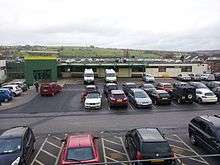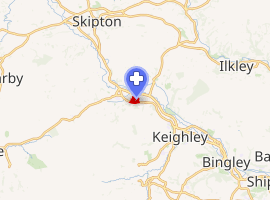Airedale General Hospital
Airedale General Hospital is an NHS district General Hospital based in Steeton with Eastburn, West Yorkshire, England and is operated by the Airedale NHS Foundation Trust.[1] Airedale was opened for patients in July 1970[2] and officially opened by the Prince of Wales on 11 December of the same year.[3] The hospital covers a wide area including Keighley, Skipton and parts of the Yorkshire Dales and eastern Lancashire. The hospital has links for Neurosurgical emergencies with Leeds General Infirmary.
| Airedale General Hospital | |
|---|---|
| Airedale NHS Foundation Trust | |
 Outpatients Department Entrance to Airedale General Hospital | |

| |
 Location in West Yorkshire | |
| Geography | |
| Location | Steeton with Eastburn, West Yorkshire, England |
| Coordinates | 53.898000°N 1.962700°W |
| Organisation | |
| Care system | NHS |
| Type | District General |
| Affiliated university | Leeds University School of Medicine |
| Services | |
| Emergency department | Yes |
| Beds | 400 |
| History | |
| Opened | 1970 |
| Links | |
| Lists | Hospitals in England |
History
The hospital was planned as far back as 1963 with many sites being optioned including Silsden and also a site nearer to Skipton. Building work was initiated in 1966 to a plan by renowned and then disgraced architect John Garlick Llewellyn Poulson.[4] His later trial had nothing to do with his designs for Airedale Hospital.[3]
The original estimate for the construction of the 32 acre site was £4.5 million including equipment. This was later revised to £5 million in 1967. The hospital, with an initial designation of 650 beds, was due to open in 1969, but was eventually opened in stages starting in July 1970.[2]
Upon opening, it was revealed that it would actually house 643 beds and have an eventual cost of £5.4 million. The maternity ward opened on 6 July 1970, after the main sections of the hospital, with the first birth being on 7 July 1970.[5] The opening of Airedale spelt the end for some of the older hospitals in the area, namely Keighley Victoria, St Johns and Mortons Bank. These all closed in 1970 on transfer of patients to the new facility.[6]
Airedale was the hospital that Tony Bland, the 96th and final Hillsborough disaster victim, was transferred to in 1989. Mr Bland was in a Persistent vegetative state (PVS) after being crushed at Hillsborough. His parents successfully applied to the High Court to cease his feeding and allow him to die, which he did on 3 July 1993.[7] The hospital was the scene of demonstrations by pro-life campaigners during this time.[8]
Services
Some 92% of patients were treated within 18 weeks in 2014–2015.[9]
See also
References
- Google Maps – location
- "60 patients switched to new hospital". Telegraph and Argus. 6 July 1970. Retrieved 17 February 2016. (subscription required)
- "Airedale General Hospital". Steetonandeastburn.co.uk. Retrieved 17 February 2016.
- "Campaign for a new hospital to serve Craven". Craven Herald. 20 December 2013. Retrieved 17 February 2016.
- "First Birth at New Hospital". Telegraph and Argus. 8 July 1970. Retrieved 17 February 2016. (subscription required)
- "Push Button Hospital". Telegraph and Argus. 6 July 1970. p. 6. Retrieved 17 February 2016. (subscription required)
- "Tony Bland died of kidney failure". The Independent. Retrieved 17 February 2016.
- White, Clive (15 April 2009). "I sometimes wonder what would Tony be like". Telegraph and Argus. Retrieved 17 February 2016.
- "AIREDALE NHS FOUNDATION TRUST Annual report and accounts 2014 – 2015" (PDF). Airedale NHS Trust. 27 May 2015. p. 15. Retrieved 14 January 2016.